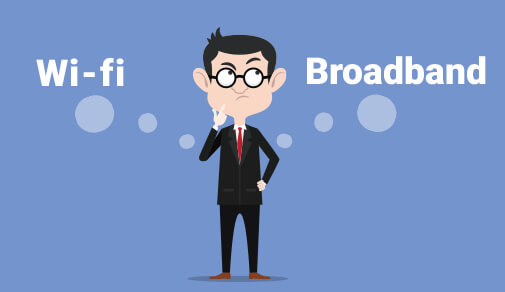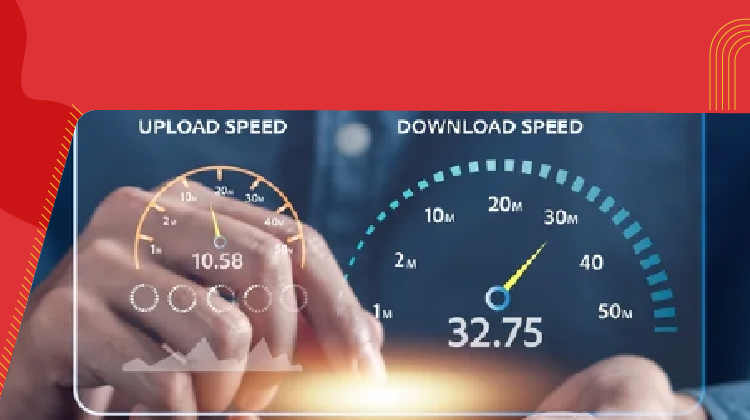Broadband vs Wi-Fi: What’s the Difference?
Friday, Oct 30, 2020 · 5 minutes


BROADBAND VS WI-FI: WHAT’S THE DIFFERENCE?
Friday, Oct 30, 2020 · 5 minutes
Hyper-connectivity is the norm these days. Being online is a luxury and a necessity for work, study, entertainment, or contact with people. In common parlance, broadband and WiFi have almost become interchangeable, yet they are different entities in the Internet environment. Their differences should be understood to know which solution best caters to your connectivity needs.
Broadband refers to internet connectivity that is always on, faster than the traditional dial-up connection. It is a blanket term for various technologies, including DSL, fiber optics, cable, and satellite communications. Essentially, broadband brings an internet connection into your home or office.
WiFi is a wireless networking technology that connects devices with the web via a router. Data travels through radio signals, allowing multiple devices such as smartphones, laptops, tablets, and smart TVs to wirelessly connect to the Internet. Basically, broadband is the pipe through which the internet comes to your home, and WiFi is how that very connection is distributed wirelessly.
A common misconception is associated with the question, “What is broadband and WiFi?”. Some people believe that broadband and WiFi are identical and often used interchangeably. While one affects overall Internet connectivity and the other helps connect multiple devices to that Internet connection, they serve a slightly different function.
Broadband is the actual internet connection coming into your premises over wires or wirelessly. This is the infrastructure giving you a hookup to the World Wide Web. Think of it simply as the water source coming to your home.
WiFi, on the other hand, acts as a delivery mechanism. It creates a wireless network with the help of a broadband internet connection, allowing devices to connect with no physical wires going from here to there. Sticking with our water analogy, WiFi is the plumbing that allows the water to be delivered to every tap in the house.
So, if you are wondering, ‘Are broadband and WiFi the same?’ they are not. One can see that without broadband, there can be no WiFi; the latter is simply seeking an Internet source that is not there. Likewise, those who have broadband may not access the Internet by means of WiFi; thus, essentially, everything remains cabled to transmit data. Together, they form a seamless system that ensures convenience and flexibility for users.
Let us make it easier to understand by explaining them in these terms:
Knowing the differences will help consumers determine what kind of service and equipment will suit their connectivity demands.
While choosing between broadband and WiFi deals, assess your specific requirements, including speed, coverage, and budget. With proper selections, non-stop internet service is waiting for you along your lifestyle. Indian providers offer great packages and bonus features to heighten your connectivity experience.
The market for broadband and WiFi in India is quite competitive, and several providers offer speed options at very affordable rates. Some of the best broadband and WiFi deals in India are listed below:
Airtel Xstream Fiber
JioFiber
ACT Fibernet
BSNL Bharat Fiber
Tata Play Fiber
When selecting a broadband or WiFi deal, consider factors like speed requirements, data limits, additional benefits, and provider reputation. Many ISPs also offer bundled packages with free OTT subscriptions or hardware, adding value to your investment.
Broadband and WiFi are an important part of modern connectivity, each serving very different roles in providing internet access. While broadband is the infrastructure in your premises to run the internet, WiFi provides a wireless connection to that connectivity over multiple devices. The two technologies go hand in, offering a seamless and versatile online experience.
If you are looking for broadband internet connection, choose ACT Fibernet. Visit our page & select the city to get going.
90

The New Social: How High-Speed Internet is Redefining 'Quality Time' with Friends and Family
Read more320

How ACT SmartWi-Fi is Redefining Home Internet in 2025: The Age of AI-Powered Seamless Connectivity
Read more129

From Bandwidth to Intelligence: How AI Is Redefining Business Demands from ISPs
Read more
A referral link has been sent to your friend.
Once your friend completes their installation, you'll receive a notification about a 25% discount on your next bill
![]() Please wait while we redirect you
Please wait while we redirect you

![]() One of our representatives will reach out to you shortly
One of our representatives will reach out to you shortly

One of our representatives will reach out to your shortly
![]() Please wait while we redirect you
Please wait while we redirect you

Please enter your registered phone number to proceed

Please enter correct OTP to proceed


Dear customer you are successfully subscribed
Please wait while we redirect you

Your ACT Shield subscription has been successfully deactivated

Dear user, Your account doesn't have an active subscription

Dear customer Entertainment pack is already activated.
Please wait while we redirect you